As with all these designs, try to start with a relatively clean, crisp
bill. It will make it much easier. All folds should be sharply creased.
It helps to go over the fold with a fingernail on a flat, hard surface.
 Start by folding the bill precisely in half lengthwise. (I prefer to fold
in toward the front of the bill. I think it produces a nicer design on the
end product. For your first attempt, it will be easier to follow exactly
the same orientation on the bill as shown in the photos.) Unfold the bill,
leaving the crease produced by the fold for the next step.
Start by folding the bill precisely in half lengthwise. (I prefer to fold
in toward the front of the bill. I think it produces a nicer design on the
end product. For your first attempt, it will be easier to follow exactly
the same orientation on the bill as shown in the photos.) Unfold the bill,
leaving the crease produced by the fold for the next step.
 Fold the bill one quarter of the way in from each side lengthwise. The
edge of the bill should just meet the crease made by the fold in the
previous step. Do this for both sides as shown.
Fold the bill one quarter of the way in from each side lengthwise. The
edge of the bill should just meet the crease made by the fold in the
previous step. Do this for both sides as shown.
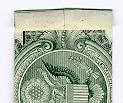 Turn the bill over. Fold the white of one end over as shown. This will
become the collar in the next step. (If the bill is printed unevenly, use
the wider edge.)
Turn the bill over. Fold the white of one end over as shown. This will
become the collar in the next step. (If the bill is printed unevenly, use
the wider edge.)
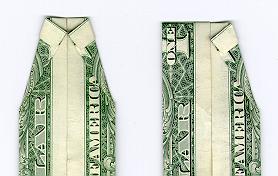 Turn the bill over again. From this side, angle-in the two corners from the
end you folded in the last step. The two points should meet precisely at
the centerline. The angle is not terribly important, but should be about
the same as shown in the photo.
Turn the bill over again. From this side, angle-in the two corners from the
end you folded in the last step. The two points should meet precisely at
the centerline. The angle is not terribly important, but should be about
the same as shown in the photo.
 Fold a little less than one third of the bill lengthwise from the opposite
end as shown. If you're following in the same orientation as the photos,
use the markings on the bill for a fold point. (Notice that the edge of
the bill just meets the word "OF" on the reverse printing.) If you
fold too little, the shirt will appear too long in the end. If you fold too
much, the next step will not work. See below.
Fold a little less than one third of the bill lengthwise from the opposite
end as shown. If you're following in the same orientation as the photos,
use the markings on the bill for a fold point. (Notice that the edge of
the bill just meets the word "OF" on the reverse printing.) If you
fold too little, the shirt will appear too long in the end. If you fold too
much, the next step will not work. See below.
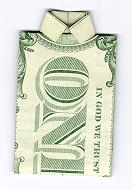 Now you will fold inward in the same direction, tucking the previous fold
under the "collar" created in step 4. So far it looks kinda
'nifty, and if you know it is supposed to look like a shirt, you get
the collar concept. But wait, there's more...
Now you will fold inward in the same direction, tucking the previous fold
under the "collar" created in step 4. So far it looks kinda
'nifty, and if you know it is supposed to look like a shirt, you get
the collar concept. But wait, there's more...
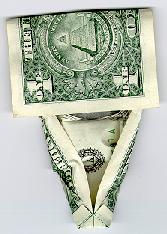 Gently unfold the previous two folds, keeping the creases. On the lateral
fold furthest from the collar, refold it strait across as shown. (On the
flatbed scanner, this made a bit of a mess of it, but it is fairly easy
in 3D.)
Gently unfold the previous two folds, keeping the creases. On the lateral
fold furthest from the collar, refold it strait across as shown. (On the
flatbed scanner, this made a bit of a mess of it, but it is fairly easy
in 3D.)
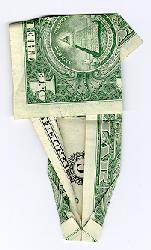 (This step is hard to describe, but it is actually fairly easy.) You are
going to introduce two new folds on each "sleeve". I do this by
holding each side of the previous fold between thumb and forefinger in the
orientation shown, just on either side of the vertical fold as shown. Just
force the angle to close slightly, and force the extra paper inside the
vertical folds. Once you've got it looking right, force the insides to
crease by pressing on a hard surface. (Try looking at the next photo - like
I said, it is hard to describe!)
(This step is hard to describe, but it is actually fairly easy.) You are
going to introduce two new folds on each "sleeve". I do this by
holding each side of the previous fold between thumb and forefinger in the
orientation shown, just on either side of the vertical fold as shown. Just
force the angle to close slightly, and force the extra paper inside the
vertical folds. Once you've got it looking right, force the insides to
crease by pressing on a hard surface. (Try looking at the next photo - like
I said, it is hard to describe!)
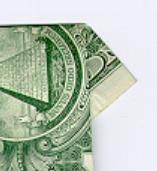 (This is a close-up of what the fold should look like when complete.) Do this
for both sides.
(This is a close-up of what the fold should look like when complete.) Do this
for both sides.
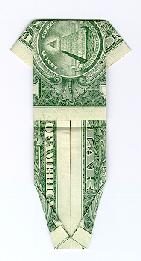 (This is what it should look like after both sides are complete.)
(This is what it should look like after both sides are complete.)
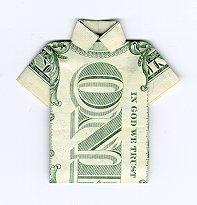 When you re-tuck the fold you've been working on back under the collar, you're
done! It should look about like this. With the basic shape, the collar and
the sleeves, it should be recognizable. Once you've done a few, you can try
folding the whole thing into the reverse side, leaving the obverse side out.
(Like I said, I think this looks better. This is especially true with 1
dollar bills where the edge seal on the reverse under the collar looks
a little bit like a necklace.)
When you re-tuck the fold you've been working on back under the collar, you're
done! It should look about like this. With the basic shape, the collar and
the sleeves, it should be recognizable. Once you've done a few, you can try
folding the whole thing into the reverse side, leaving the obverse side out.
(Like I said, I think this looks better. This is especially true with 1
dollar bills where the edge seal on the reverse under the collar looks
a little bit like a necklace.)
 Start by folding the bill precisely in half lengthwise. (I prefer to fold
in toward the front of the bill. I think it produces a nicer design on the
end product. For your first attempt, it will be easier to follow exactly
the same orientation on the bill as shown in the photos.) Unfold the bill,
leaving the crease produced by the fold for the next step.
Start by folding the bill precisely in half lengthwise. (I prefer to fold
in toward the front of the bill. I think it produces a nicer design on the
end product. For your first attempt, it will be easier to follow exactly
the same orientation on the bill as shown in the photos.) Unfold the bill,
leaving the crease produced by the fold for the next step. Fold the bill one quarter of the way in from each side lengthwise. The
edge of the bill should just meet the crease made by the fold in the
previous step. Do this for both sides as shown.
Fold the bill one quarter of the way in from each side lengthwise. The
edge of the bill should just meet the crease made by the fold in the
previous step. Do this for both sides as shown. Turn the bill over. Fold the white of one end over as shown. This will
become the collar in the next step. (If the bill is printed unevenly, use
the wider edge.)
Turn the bill over. Fold the white of one end over as shown. This will
become the collar in the next step. (If the bill is printed unevenly, use
the wider edge.) Turn the bill over again. From this side, angle-in the two corners from the
end you folded in the last step. The two points should meet precisely at
the centerline. The angle is not terribly important, but should be about
the same as shown in the photo.
Turn the bill over again. From this side, angle-in the two corners from the
end you folded in the last step. The two points should meet precisely at
the centerline. The angle is not terribly important, but should be about
the same as shown in the photo. Fold a little less than one third of the bill lengthwise from the opposite
end as shown. If you're following in the same orientation as the photos,
use the markings on the bill for a fold point. (Notice that the edge of
the bill just meets the word "OF" on the reverse printing.) If you
fold too little, the shirt will appear too long in the end. If you fold too
much, the next step will not work. See below.
Fold a little less than one third of the bill lengthwise from the opposite
end as shown. If you're following in the same orientation as the photos,
use the markings on the bill for a fold point. (Notice that the edge of
the bill just meets the word "OF" on the reverse printing.) If you
fold too little, the shirt will appear too long in the end. If you fold too
much, the next step will not work. See below. Now you will fold inward in the same direction, tucking the previous fold
under the "collar" created in step 4. So far it looks kinda
'nifty, and if you know it is supposed to look like a shirt, you get
the collar concept. But wait, there's more...
Now you will fold inward in the same direction, tucking the previous fold
under the "collar" created in step 4. So far it looks kinda
'nifty, and if you know it is supposed to look like a shirt, you get
the collar concept. But wait, there's more... Gently unfold the previous two folds, keeping the creases. On the lateral
fold furthest from the collar, refold it strait across as shown. (On the
flatbed scanner, this made a bit of a mess of it, but it is fairly easy
in 3D.)
Gently unfold the previous two folds, keeping the creases. On the lateral
fold furthest from the collar, refold it strait across as shown. (On the
flatbed scanner, this made a bit of a mess of it, but it is fairly easy
in 3D.) (This step is hard to describe, but it is actually fairly easy.) You are
going to introduce two new folds on each "sleeve". I do this by
holding each side of the previous fold between thumb and forefinger in the
orientation shown, just on either side of the vertical fold as shown. Just
force the angle to close slightly, and force the extra paper inside the
vertical folds. Once you've got it looking right, force the insides to
crease by pressing on a hard surface. (Try looking at the next photo - like
I said, it is hard to describe!)
(This step is hard to describe, but it is actually fairly easy.) You are
going to introduce two new folds on each "sleeve". I do this by
holding each side of the previous fold between thumb and forefinger in the
orientation shown, just on either side of the vertical fold as shown. Just
force the angle to close slightly, and force the extra paper inside the
vertical folds. Once you've got it looking right, force the insides to
crease by pressing on a hard surface. (Try looking at the next photo - like
I said, it is hard to describe!) (This is a close-up of what the fold should look like when complete.) Do this
for both sides.
(This is a close-up of what the fold should look like when complete.) Do this
for both sides. (This is what it should look like after both sides are complete.)
(This is what it should look like after both sides are complete.) When you re-tuck the fold you've been working on back under the collar, you're
done! It should look about like this. With the basic shape, the collar and
the sleeves, it should be recognizable. Once you've done a few, you can try
folding the whole thing into the reverse side, leaving the obverse side out.
(Like I said, I think this looks better. This is especially true with 1
dollar bills where the edge seal on the reverse under the collar looks
a little bit like a necklace.)
When you re-tuck the fold you've been working on back under the collar, you're
done! It should look about like this. With the basic shape, the collar and
the sleeves, it should be recognizable. Once you've done a few, you can try
folding the whole thing into the reverse side, leaving the obverse side out.
(Like I said, I think this looks better. This is especially true with 1
dollar bills where the edge seal on the reverse under the collar looks
a little bit like a necklace.)